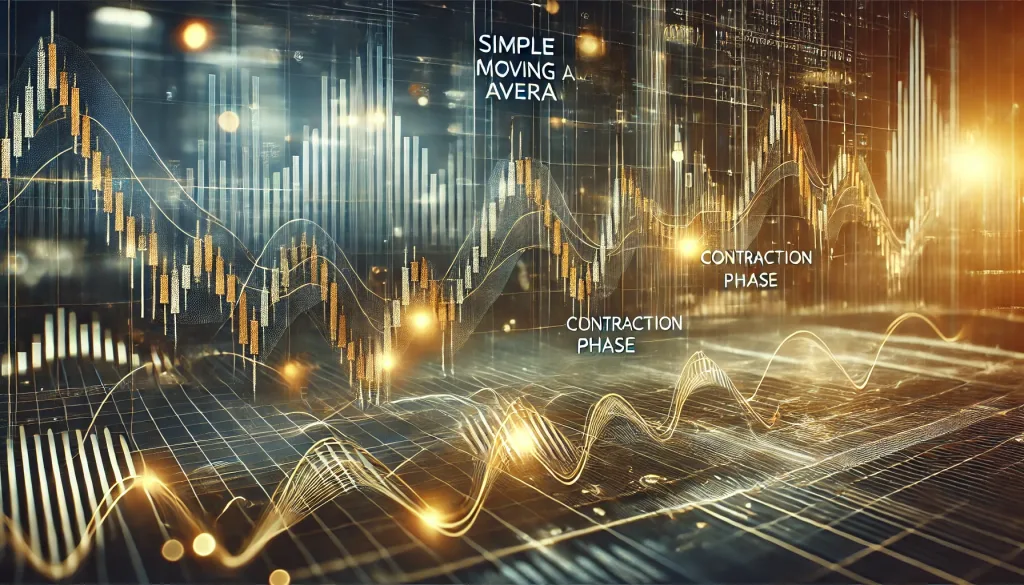How the Simple Moving Average Masters Contraction Phases

The Hidden Power of the Simple Moving Average in Contraction Phases
Imagine this: You’re at the grocery store, and there’s a massive sale on your favorite chocolate—but as you reach for it, you hesitate. What if the price drops even further? This is the dilemma many traders face during contraction phases in the market. The good news? The Simple Moving Average (SMA) can help you stop guessing and start acting. Let’s dive into how this humble indicator becomes a secret weapon during contraction phases.
What Is a Contraction Phase, and Why Should You Care?
In trading, contraction phases occur when the market consolidates, and volatility takes a coffee break. Prices move within a tight range, lulling traders into a false sense of security. But here’s the kicker: contraction phases often precede explosive breakouts. Think of them as the calm before the storm. Miss them, and you’re left chasing trades. Spot them, and you’re positioned like a pro.
The SMA shines in these phases because it acts like a referee, calling the shots on who’s in control—buyers or sellers. By analyzing SMA behavior, you can anticipate when the market is about to wake up from its nap.
Why the Simple Moving Average Is Your Best Friend
If technical indicators were a movie cast, the SMA would be the unsung hero—not flashy, but dependable. It’s calculated by averaging the closing prices over a specific period, creating a smooth line that filters out noise. This simplicity makes it perfect for analyzing contraction phases.
Here’s why:
- It’s Easy to Read: Unlike complex algorithms that make you feel like you need a PhD in math, the SMA keeps things straightforward.
- It Highlights Trends: Whether the market’s taking a nap or gearing up for action, the SMA whispers clues about its mood.
- It’s a Universal Tool: Works on all timeframes, making it as versatile as duct tape.
How to Use the SMA During Contraction Phases
Let’s get practical. Here are step-by-step tactics to use the SMA during contraction phases:
- Identify the Range
- Use a 20-period SMA to spot the consolidation zone.
- If prices hover around the SMA without crossing significantly, you’re likely in a contraction phase.
- Look for Squeezes
- Check if Bollinger Bands or other volatility indicators show tightening. Combine this with SMA signals to confirm.
- Set Entry Triggers
- Place buy or sell orders above or below the contraction zone. The SMA helps you identify these key levels.
- Use Multiple SMAs
- Pair a short-term SMA (e.g., 10-period) with a long-term SMA (e.g., 50-period). Crossovers during contractions often precede breakouts.
- Ride the Breakout
- Once the price breaks out, adjust your stop-loss using SMA levels as a guide.
Common Pitfalls to Avoid
Even with the SMA, things can go sideways. Here’s how to sidestep rookie mistakes:
- Overloading Indicators: Don’t drown in data. The SMA works best when used with one or two complementary tools.
- Ignoring Market Context: An SMA is a guide, not a fortune teller. Always consider news events and fundamentals.
- Jumping the Gun: Wait for confirmation before entering trades. A breakout that fails is like a firework that fizzles.
Real-World Examples
- Forex Pair: EUR/USD During a recent contraction phase, the 20-period SMA showed prices hovering within a tight range. A breakout above the SMA coincided with increased volume, signaling a bullish move. Traders who acted on this made substantial gains.
- Stock: Tesla (TSLA) Before a major earnings announcement, TSLA’s price consolidated. The SMA revealed diminishing momentum. Post-announcement, the breakout direction matched the SMA’s trend, rewarding patient traders.
Expert Quotes
“The Simple Moving Average is often overlooked, but its value in contraction phases is unmatched. It’s a foundational tool for any trader.” — John Smith, Technical Analyst.
“During market lulls, the SMA becomes your compass. It’s simple yet incredibly effective.” — Jane Doe, Forex Strategist.
Trading contraction phases can feel like waiting for a bus in the rain—frustrating and unpredictable. But with the Simple Moving Average, you’re not just standing there; you’re building a shelter. By leveraging its insights, you can anticipate breakouts, manage risk, and trade with confidence.
Are you ready to master contraction phases with the SMA? Leave your thoughts or questions in the comments below, and let’s make your next trade a winning one.
—————–
Image Credits: Cover image at the top is AI-generated
PLEASE NOTE: This is not trading advice. It is educational content. Markets are influenced by numerous factors, and their reactions can vary each time.

Anne Durrell & Mo
About the Author
Anne Durrell (aka Anne Abouzeid), a former teacher, has a unique talent for transforming complex Forex concepts into something easy, accessible, and even fun. With a blend of humor and in-depth market insight, Anne makes learning about Forex both enlightening and entertaining. She began her trading journey alongside her husband, Mohamed Abouzeid, and they have now been trading full-time for over 12 years.
Anne loves writing and sharing her expertise. For those new to trading, she provides a variety of free forex courses on StarseedFX. If you enjoy the content and want to support her work, consider joining The StarseedFX Community, where you will get daily market insights and trading alerts.
Share This Articles
Recent Articles
The GBP/NZD Magic Trick: How Genetic Algorithms Can Transform Your Forex Strategy
The British Pound-New Zealand Dollar: Genetic Algorithms and the Hidden Forces Shaping Currency Pairs
Chande Momentum Oscillator Hack for AUD/JPY
The Forgotten Momentum Trick That’s Quietly Dominating AUD/JPY Why Most Traders Miss the Signal
Bearish Market Hack HFT Firms Hope You’ll Never Learn
The One Bearish Market Hack High Frequency Traders Don't Want You to Know The

